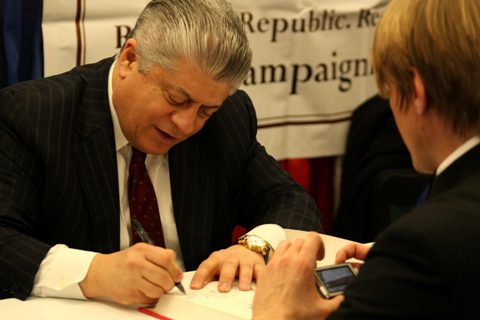Is Social Security one big Ponzi Scheme? In the real world, if an investment guru such as Bernie Madoff is found to be broke and having to scramble to find new investors so he can continue to pay dividends to old investors – he ends up in court.
If it’s discovered that he didn’t bother to invest their funds at all – instead paid himself an exorbitant salary and squandered the money – he goes to jail.
Operators of Ponzi schemes usually entice new investors by offering higher returns than other investments. Paying such high returns requires an ever-increasing flow of money from new investors to sustain the scheme.
Rick Perry (Photo by Gage Skidmore/Flickr)
“When Texas Governor Rick Perry referred to Social Security as ‘a Ponzi scheme,’” writes Judge Andrew Napolitano, ”he was excoriated by the press, left and right, and by his fellow Republicans, as well.”
After all, our government wouldn’t do such a thing, would it?
“For many baby boomers, it’s comforting to believe that part of the 12.4 percent Social Security payroll tax they (or they and their employer) have been paying is going into a $2.7 trillion Social Security Trust Fund,” writes economist and retired professor Allen W. Smith.
However, Smith says there is no trust fund – and a number of elected officials, including former President George W. Bush, have acknowledged that.
“To make a long story very short, we are supposed to have $2.7 trillion in Social Security surplus, all earmarked for the baby boomers’ retirement, due to money generated by amendments approved in 1983,” says Smith, author of The Looting of Social Security. “But there’s no money in the fund.”
“This revelation should come as no surprise to those who monitor the government and its deceptive ways,” says Napolitano. “When he first introduced Social Security, President Franklin D. Roosevelt argued that under Social Security the federal government would be holding your money for you. He deceptively fostered the idea that Social Security would be a savings account, into which employees and employers would make contributions and out of which guaranteed monies would be paid to those who reached the age of 65. Essentially, he claimed that you’d get your money back.
“Eventually, the government would acknowledge that what it first called a savings account and then called old-age insurance and then said would be fortified by a trust fund did not even establish a contractual obligation to those who have paid the Social Security tax — which would be all of us.
“The politicians believed him,” writes Napolitano, “but the actuaries and the judiciary understood that the government would never hold anyone’s money for him — as if it were the custodian of a bank account. In the first of several challenges to the constitutionality of Social Security, the Supreme Court found that the Social Security fund did not consist of your money. It was merely tax revenue. Did you know that?
“And, in a curious yet revealing one-liner in the Supreme Court opinion upholding the constitutionality of Social Security, even the court recognized that there would be no trust fund in the traditional sense when it found that the tax dollars collected and supposedly designated for Social Security were ‘not earmarked in any way.’
“Thus,” writes Napolitano, “the Feds have conceded and the courts have agreed that the money you have involuntarily contributed to
the so-called trust fund is not yours and can be spent by the government as it pleases, just like any other revenue that the Feds collect.
Andrew Napolitano (Photo by Gage Skidmore/Flickr)
“Where did it go?” asks Smith. Four administrations, from Reagan to George W. Bush, spent it on myriad non-Social Security efforts, says Smith – so don’t blame the current president.
“Obama didn’t have a chance to use it – it was gone,” Smith says.
The 1983 amendments approved under Reagan generated revenue by accelerating Social Security payroll tax increases, allowing a portion of benefits to be taxed, and delaying cost-of-living adjustments from June to December.
According to the Social Security Administration website: “The surpluses are invested in (and the trust fund holds) special-issue Treasury bonds.” But what’s actually sitting in the Trust Fund is non-marketable government IOUs – worthless, Smith says.
The fact has been publicly acknowledged by a 2009 Social Security trustees report; Sen. Tom Coburn; and President George W. Bush, who in 2005 said, “There is no trust fund, just IOUs that I saw firsthand … future generations will pay – pay for either in higher taxes or reduced benefits or cuts to other critical government programs.”
Recently, Speaker of the House John Boehner offered a sobering statement on ABC’s “This Week,” on Oct. 6, 2013: “…Ten thousand baby boomers like me (are) retiring every single day – 70,000 this week; 3.5 million this year. And, it’s not like there’s money in Social Security or Medicare. The government, over the last 30 years, has spent it all.”
So, are we all doomed?
Will Baby Boomers get their retirement checks?
Smith says there is hope.
However, he says Congress must admit the truth. “The total cost of paying full benefits in 2010 exceeded Social Security tax revenue by $49 billion,” says Smith, “and the gap between revenue and costs will become larger in the coming years.
“On Sept. 27, 2000, I appeared on CNN Today to discuss my book, The Alleged Budget Surplus, Social Security, and Voodoo Economics. The host did not take me seriously and asked me if I was ‘a voice crying in the wilderness,’ ” Smith says. “I’d quickly realized that he was right, with the exception of multiple statements by politicians and officials.”
He says it’s time that Baby Boomers start protesting – demanding answers from Congress.
“Boomers are no strangers to taking to the streets to express their outrage.”
So, dust off those 1970s protest signs.
Demand answers, says Smith.
Get involved – and force Congress to make sure that the unthinkable never happens.



